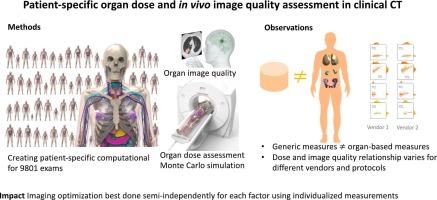Patient-specific organ dose and in-vivo image quality assessment in clinical CT
IF 2.7
3区 医学
Q1 RADIOLOGY, NUCLEAR MEDICINE & MEDICAL IMAGING
Physica Medica-European Journal of Medical Physics
Pub Date : 2025-06-26
DOI:10.1016/j.ejmp.2025.105017
引用次数: 0
Abstract
Purpose
To develop and characterize individualized dose and quality measures at organ level compared to their generic counterparts across a clinical CT dataset.
Materials and methods
The study included 9801 chest-abdomen-pelvis and abdomen-pelvis CT exams (7,763 patients, mean age, 56 ± 17 years; 4113 women) representing 20 unique protocols. For each exam, patient-specific organ dose of all radiosensitive organs was estimated using a validated method by generating personalized computational phantoms and Monte Carlo simulations. Effective dose () was calculated by weighted sum of the organ doses. Liver dose, , noise in the liver, , and observer model detectability, , were assessed within the liver as examples of individualized, organ-based image assessment measurements. The organ-based measurements (, , and ) were compared to their generic counterparts: ssize-specific ddose estimates (SSDE), effective dose based on dose length product (), and whole-body noise (), respectively.
Results
Generic dose values were substantially higher than individualized estimates for SSDE vs. (median of all exams: 51.2 %, p < 0.001) and vs. (median: 41.0 %, p < 0.001). was generally lower than (median: −7.2 %, p < 0.001). The correlation relationships of and were substantially varied ( range: 0–0.5) for different patient sizes and scan parameters.
Conclusions
Demonstrated across a population of exams, individualized organ-based measurements of dose and quality are feasible. Generic measures cannot fully represent individualized organ-based values. The correlation relationships between individualized dose and image quality values varies for different vendors and protocols, implying imaging optimization is best when done semi-independently for each factor using individualized measurements.

临床CT中患者特异性器官剂量和体内图像质量评估
目的:在临床CT数据集中,与通用剂量和质量测量相比,在器官水平上开发和表征个体化剂量和质量测量。材料与方法本研究纳入9801例胸腹骨盆和腹部骨盆CT检查(7763例,平均年龄56±17岁;4113名女性),代表了20种不同的方案。对于每次检查,所有放射敏感器官的患者特异性器官剂量使用一种经过验证的方法,通过生成个性化的计算幻影和蒙特卡罗模拟来估计。有效剂量(EOD)由各器官剂量加权和计算。肝脏剂量、ODliver、肝脏噪声、Nliver和观察者模型可检测性d '作为个体化、基于器官的图像评估测量的例子,在肝脏内进行评估。将基于器官的测量(ODliver、EOD和Nliver)分别与它们的通用对应方法:尺寸特异性剂量估计(SSDE)、基于剂量长度积的有效剂量(EDLP)和全身噪声(Nglobal)进行比较。结果SSDE和ODliver的通用剂量值明显高于个体化估计(所有检查的中位数:51.2%,p <;0.001)和EDLP vs. eddod(中位数:41.0%,p <;0.001)。Nglobal普遍低于Nliver(中位数:−7.2%,p <;0.001)。不同患者体型和扫描参数下,EOD与d′的相关关系有很大差异(R2范围:0-0.5)。结论:通过大量的检查证明,个体化的基于器官的剂量和质量测量是可行的。通用措施不能完全代表个体化器官价值。个体化剂量与成像质量值之间的相关关系因不同的供应商和方案而异,这意味着使用个体化测量对每个因素进行半独立的成像优化是最好的。
本文章由计算机程序翻译,如有差异,请以英文原文为准。
求助全文
约1分钟内获得全文
求助全文
来源期刊
CiteScore
6.80
自引率
14.70%
发文量
493
审稿时长
78 days
期刊介绍:
Physica Medica, European Journal of Medical Physics, publishing with Elsevier from 2007, provides an international forum for research and reviews on the following main topics:
Medical Imaging
Radiation Therapy
Radiation Protection
Measuring Systems and Signal Processing
Education and training in Medical Physics
Professional issues in Medical Physics.

 求助内容:
求助内容: 应助结果提醒方式:
应助结果提醒方式:


